The Perfect Halloween Game for those who have already played all the Good Halloween Games
The 90s were a highly experimental time in gaming. The advanced power of 5th generation consoles blew the doors wide open on what programmers could create, both audio-visually and in terms of gameplay paradigms. Tried and true genres and styles quickly fell out of favor, as gamers and publishers alike clamored for gaming experiences that pushed boundaries; experiences that had never been possible before. Developers wasted little time capitalizing on all they ways they now ‘could’ do things, long before giving any thought about whether they ‘should’ do them that way. It was during this exciting, on-the-frontier, “wild west” time in gaming that the FMV genre rose to prominence.
Caught up in the genre’s meteoric rise and just as swift decline was the intrepid Digital Pictures. Once the darlings of digital entertainment (well, that’s probably pushing it), their entire catalogue consisted of FMV-based games. As the 5th generation got underway in earnest with the release of the Saturn and PlayStation, the FMV ‘fad’ was quickly waning. Digital Pictures suddenly found themselves a very polarizing publisher, caught between trail-blazing respectability and ridicule almost overnight.

This wasn’t entirely fair to Digital Pictures. They can’t be blamed for a lack of belief in the FMV medium, nor for a shortness of ambition in making their products look as good as possible with live actors, realistic sets, and elaborate costumes. It took serious money to produce these titles, especially during a time that AAA development teams were still relatively small. It’s simply that, much like HD DVD or Betamax, their product made a splashy debut but never truly caught on.
Enter Corpse Killer. The game started life (ha ha) on the SEGA CD, with predictably bordered and grainy video on par with that system’s offerings of the time. The game was then resurrected (ha ha ha) with a SEGA CD 32X release, based on the SEGA CD original but taking advantage of the 32X’s expanded color palette for significantly better video. It wound up being one of only six SEGA CD 32X titles released worldwide. The game’s final 1990s incarnation (ho ho!) was on the SEGA Saturn, and featured even better-quality video that did away with the borders and presented in full screen. There were also iterations for the PC, Mac, and even the 3DO, although these were based on the SEGA CD original and did not feature the refinements of the Graveyard Edition.
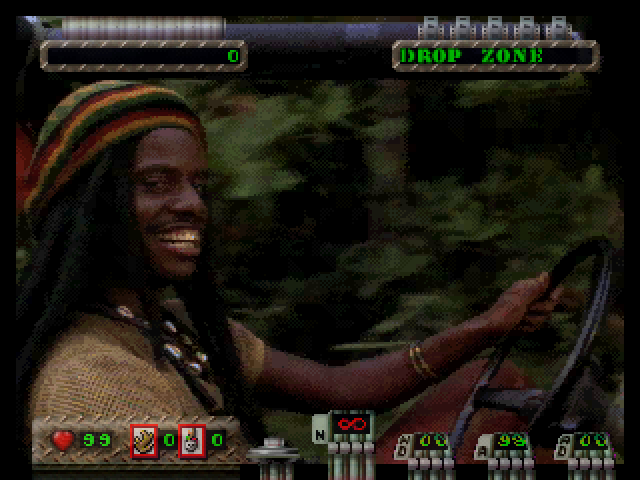
The game’s story is quite perfect for Halloween season. The unsavory necrobiologist Dr. Elgin Hellman was initially linked to the US Army under a secret project code-named Operation Manpower. Their aim was to create an army of undead soldiers, to be used in lieu of living American servicemen in times of conflict. For reasons unclear, Hellman has gone rogue and set up camp on the small tropical island of Puerto Rico Cay Noir. There, he uses his dark arts to reanimate zombie-slaves, but these aren’t for the military… they are here to do his bidding. The army, burnt by this apparent betrayal and concerned about his intentions, sends in a group of four highly trained officers to take him out… but Hellman turns the tables on them pretty quick, and captures them all. Now, you, an unnamed marine lieutenant, are airdropped solo onto the island and are tasked with both freeing your comrades and putting an end to the ghoulish necrobiologist’s nefarious schemes.
You immediately meet Winston, a treasure-hunting Rastafarian who acts as your guide and driver and who is stereotypically cringe in every way possible. He loves Hummers and is looking to find buried pirate gold on the island to finance a new set of wheels. Also popping out of nowhere is blonde bombshell reporter Julie, who has been following the Operation Manpower story for months and will do whatever it takes to get her big scoop on the island’s goings-on. She feels that breaking this story will catapult her to the elite level of reporters, nationwide.
Functionally, Julie serves as a nice conversational counterpoint to Winston and as a catalyst to progressing the story. Winston is far more important to the gameplay. Familiar with the island’s native flora as well as ancient voodoo arts, he brews potent concoctions capable of both refilling your life between levels and bringing your zombified platoon mates back to the world of the living. His life-giving potion is quite vital, especially as you only get one try in this game. Should your health fall to zero at any point, it’s game over regardless of how far you’ve progressed. Thankfully, a save function becomes available relatively early in the game.
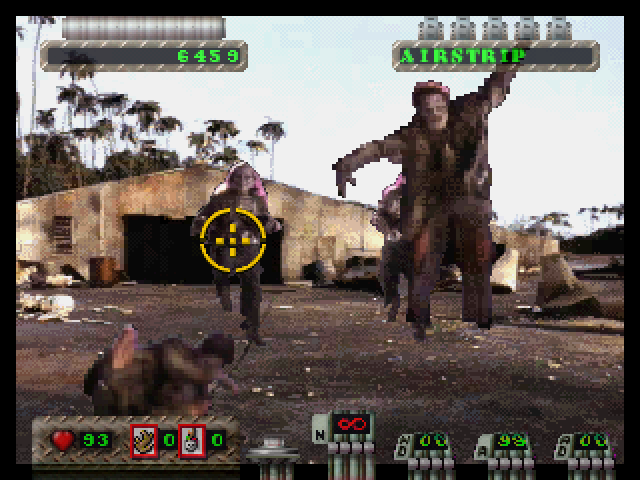
Winston can make use of those same ingredients to brew a juice to coat your bullets and make them extra-effective against the undead. By default, you posses a regular gun with unlimited ammo as well as one that can shoot armor-piercing bullets, which you must find and replenish as you use them. Winston’s special brew coats both types of bullets, effectively doubling the player’s available ammunition types. The four weapons are assigned to buttons A (standard / unlimited), C (armor piercing), X (standard coated with Datura) and Z (armor piercing and coated with Datura). Some zombies take more than one standard bullet to dispatch so the more powerful – but limited – bullets come in handy, while the in-your-face pop-up zombies can only be waylaid with Datura-coated armor piercing bullets.
As the driver, Winston sets you up for run-and-gun passes through the game’s various locales. The core gameplay consists of a first-person side view from Winston’s Jeep – essentially, scrolling landscapes ranging from jungle to beachfront to ruins to the Dr.’s fortress – upon which digitized zombies are superimposed. These undead denizens either shuffle along, leap out at you, or even, exclusively in the Saturn version, pop up at ultra-close range to take a bite out of your delicious flesh! You guide a crosshair across the screen and fire away, blasting through a zombie gallery, hoping to survive. The zombies get faster and faster the further you progress in the adventure.
Aside from your standard zombie, there are mysterious other undead that take special actions to dispatch. Supernatural Shadow-men, for instance, are zombie creatures who shift back and forth from glimmering all white to all black. Kill them while they’re white, and all nearby zombies die as well. Kill them while they’re black, and you suffer damage. Other special enemies include Black Magic Strawmen and Reapers. Both of these require Datura-coated bullets to dismiss; killing them with regular bullets is either ineffective or results in you taking damage.
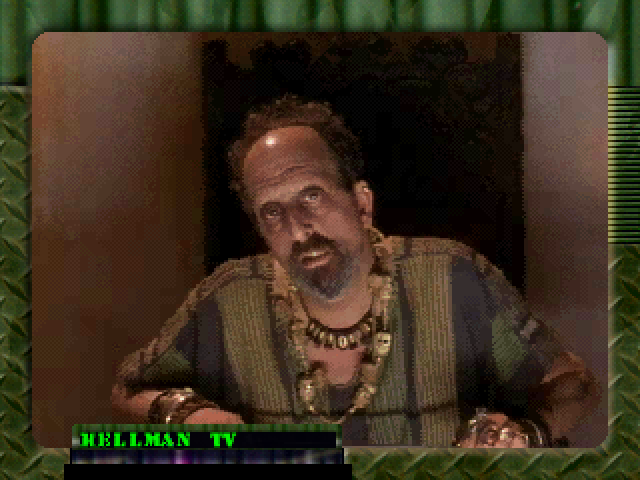
Exclusive to the Saturn version are small icons that drop down amidst the zombie-slaying action, which the Lieutenant can claim by shooting. They vary in size, potency, and drop speed, and consist of either health mugs (slight health boost), bullets (replenish armor-piercing bullets), or voodoo skulls, which damage you. The addition of the harmful skulls is quite brilliant and serves to discourage simply holding down the fire button and moving the crosshairs back and forth across the screen, and to be more attentive and discriminate with your shooting. As you finish each level, Winston may be able to make something out of the native Datura plant for you: the choice between a mug of Breath (restores health) or coated bullets is yours.
Once the first marine is rescued, the trio of yourself, Julie, and Winston make it to the graveyard. Most logically indeed, the graveyard serves as your base of operations. You finally have time to use your army-issue, tablet-like Datapod. Said Datapod allows for game saving, viewing of short FMV clips that help flesh out (ohhh) some of the game’s backstory, and finally, accesses Elon Musk’s powerful StarLink satellite network… ahhh, nuts. That was a slight anachronism. The real deal here is called the SatLink. SatLink gives you a realtime overhead view of the island and where groups of zombies may be congregating, allowing you to pick your next destination.
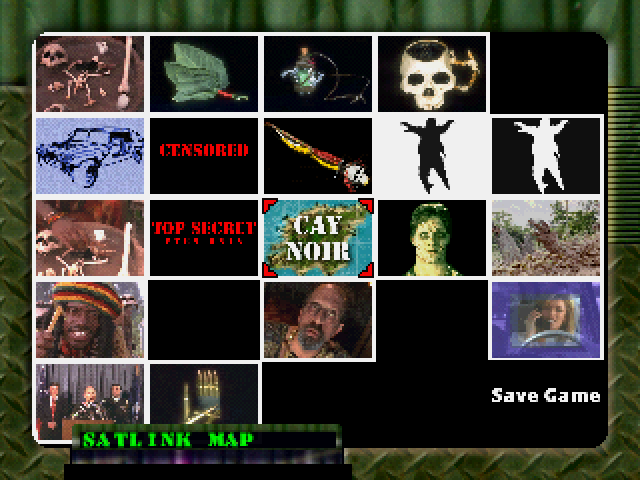
Your ultimate goal is to make repeated runs into Hellman’s fortress, affectionately called Zombietown. Successfully finishing a run through the Fortress results in an encounter with, and hopefully the rescue of, one of your four zombified army mates. However, SatLink also shows other destinations of interest, should you choose to engage in some side-questing. Missions include a few bonus runs which can reward you with extra Datura plant, juju sticks (enchanted branches that ward off certain zombies), and unlock a few other FMV clips. They aren’t core to the gameplay but will outfit you better for the inevitable encounter with the Doctor of Death, and of course provide more FMVs of Julie and Winston to savor. There are also a couple of side quests specific to Winston and Julie’s stories. These aren’t essential to completing the game, but there is a certain satisfaction to helping Winston find his treasure or seeing Julie get her big scoop. Great stuff.

At some point however, you’ll want to take your best shot at the dreaded necrobiologist’s fortress. Reaching the fortress involves going through either the swamp or the village. These two locales serve as prep levels that can be replayed over and over in the hopes of maximizing your health and ammunition, before starting your assault on the dreaded Fortress itself. Once sufficiently ready, the trio infiltrate Zombietown and blast their way through three progressively harder sections until enough damage has been caused to waylay the area boss, which happens to be one of your zombified platoon buddies.
This is where the brilliance of the game comes into play. While the game is certainly worth the price of admission to see the b-movie plot play out, gameplay-wise, these sections require delicate balancing of health and inventory. Both on the island proper and on fortress assaults, the Lieutenant can take as many runs through auxiliary levels as they please, trying to stock up on as much health and bullets as possible whilst avoiding taking damage. Some runs will be easier and more successful; others may be extremely punishing and set the player back. You, the player, must at some point decide when the odds are at their most favorable and make your daring run at the Fortress / Zombietown. Further, the longer the Lieutenant tarries at the auxiliary levels, the higher the chance that zombies will ambush you at the graveyard. An attack on the graveyard means coming back to defend your home base, risking your health and depleting your resources for no gain whatsoever. The game thus presents an intriguing health / ammo balancing act for the player to contend with. Quite well done indeed and easily the biggest hook this title offers.
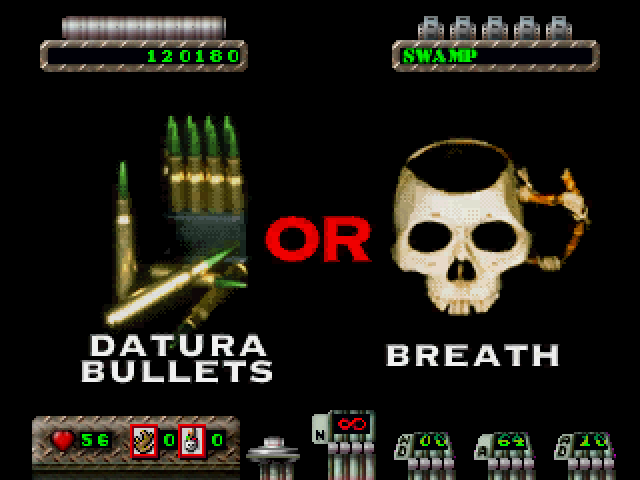
Each successive rescue must follow the same formula: roam Cay Noir, dispatch random zombies to collect ammo and health, then play through the Swamp and/or Village, and take a run at Hellman’s headquarters. Eventually you rescue all of your buddies and only the evil doctor remains, and you must use all your wits to break the zombie king’s hold over the unnatural army he has risen. No easy task, though it must be said that as a final boss, Hellman is underwhelming. While your platoon buddies are tough as nails and offer increasingly tough resistance, Hellman is more of a ‘do as I say, not as I do’ type of evil leader. He stands in place and commands hoards of undead to attack you. He isn’t overly difficult to subdue.
Visually, the video is better here than in any contemporary edition. It is the only version to run the game’s FMV in full screen, taking advantage of the Saturn’s considerable 5th-gen muscle. The FMV plays at a respectable framerate and makes nice use of the Saturn’s color palette. Other editions are bordered, so the full-screen display here is really lovely in comparison. The actors’ voices come through crisp and clear, though Winston is at times difficult to understand, owing to his thick accent. Production values are clearly quite high, with the sets being well-dressed and the actors donned in convincing costumes and makeup. The acting is also excellent, especially for an era where voice acting was generally terrible.
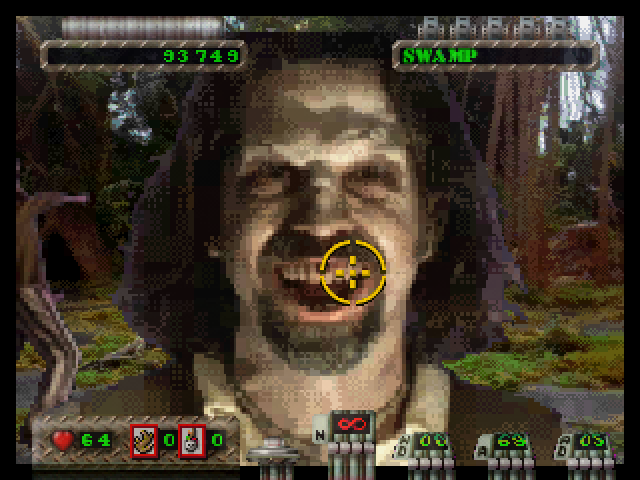
The scenes with Winston (Jeremiah Birkett) and Julie (Bridget Butler) are pure zombie b-movie gold, and the occasional videos of the mad scientist Dr. Hellman (the late Vincent Schiavelli) are absolutely awesome. All three are a delight to experience. The acting, storyline, and costumes / makeup are overall so b-movie bad that they’re unintentionally, deliciously good. To be clear: despite being about zombies and evil scientists, this game will not scare you, but it will certainly entertain this Halloween. Some of the game’s more cringy stereotypes must be taken in context: this was the 1990s, and our cultural sensitivity was not as refined as it is today. When seen through this prism, the game offers good, clean, wholesome zombie-blasting fun.
While playing, small HUD-like displays take up residence in the corners of the screen. These took up a lot of real estate in other versions, serving to reduce the FMV video size, but on the mighty Saturn they are reduced to their minimum and are simply arranged overtop the video. The Saturn version even sports an option to turn the minimalist on-screen HUD elements to various shades of transparency! Yes, the wizards at Digital Pictures fully harnessed the platform’s strengths to deliver as solid an experience as possible… or did they?
(A Lack of) Peripheral Power!
The Saturn version of the game commits a cardinal sin: the game DOES NOT support the light gun! Yes – a shooting game on a platform with a solid, arcade quality build first-party light gun, and no light gun support. All other contemporary console versions – SEGA CD, SEGA CD 32X, and even the 3DO – supported a light gun. No such luck here. An absolutely corpse-killing mistake that easily takes the experience down a few notches. Although the on-screen crosshair, controlled by the d-pad, works well enough, as zombies get faster in later levels, the time it takes for it to travel across the screen can lead to some frustration. It remains a mystery why light gun support wasn’t programmed in, especially as Digital Pictures took the time to do so in every other version. Perhaps it was a case of trying to get the game finished and shipped in time for the crucial Christmas selling period. We can only speculate.
This game (and frankly all Digital Pictures’ Saturn titles) would also have been a perfect showpiece for the Saturn’s VideoCD / MPEG card. Never released in North America, the card saw multiple iterations by various companies in Japan, and even received a limited European release. Video cards fit into the recess in the Saturn’s battery compartment and enable the Saturn to decode the MPEG-1 / White Book video standard. Several Japanese Saturn games take advantage of the card to offer higher fidelity FMV scenes, so Corpse Killer would have fit the bill beautifully. As with the light gun, it is a disappointment that it didn’t, especially as Digital Pictures were known to take advantage of obscure hardware configurations for their games (see SEGA 32X CD games catalogue).
No Video card support… no light gun support… Foo-Pah!
The Graveyard Edition
Saturn Corpse Killer was released as the Graveyard Edition, as it featured a few new aspects and enhancements not seen in other releases. For one, the enemies now move noticeably faster than ever before. There are new, ‘full screen’ zombies that pop up from time to time, requiring the use of Datura bullets to dispatch. The falling icons of health, bullets, and skulls add a dimension to the game that is absent in other versions. The scrolling backgrounds, which moved fairly slowly and at a distractingly low framerate in other editions, now scroll swiftly and actually animate quite smoothly. The game’s HUD is minimalized and can be adjusted in real time from solid color to transparent to barely visible, so as to further maximize the video area on the screen. There’s also a much nicer interface for selecting missions on Cay Noir. However, no new video clips or extra missions were added to this edition. Is the Graveyard Edition the very best way to experience Corpse Killer? If you aren’t too keen on using a light gun, then yes – the minor refinements to the game and the enhanced video quality make this the version to go for.
This game is a wonderful 32-bit enigma. Upon release, reviews ranged from middling to terrible, and the game never sold by the bucketful. Even in the early 2020s, it is not entirely rare to find sealed Saturn copies of this title. At the time, gamers derided the limited gameplay and the heavy use of cheesy, corny FMV scenes, but these have aged remarkably well and now account for much of the enjoyment the game provides – if not necessarily as originally intended. As the title of this piece suggests, this is not one of the top tier Saturn Halloween games, but it is perhaps the best Saturn Halloween game to play once you’ve played all the real best Saturn Halloween games.
Activating Sarcasm Engine
As it tried to combat the upstart PlayStation, SEGA of America was lucky enough to lock up Corpse Killer: Graveyard Edition as a Saturn exclusive. The lack of a PlayStation version was a rightful poke in Sony’s eye, and with Nintendo’s choice of cartridges as their medium of choice, the Nintendo 64 did not have sufficient memory (read: it didn’t have the power!!) required to run this masterpiece. Not only that, but Corpse Killer is a North American Saturn exclusive, catering solely to the discerning American gamer. Another obvious win for the Saturn and SEGA’s brilliant marketing strategy in the West.
Enjoy!

Modern, HD Remasters
Believe it or not, in 2019, the game was remastered in high definition for PlayStation 4 and Steam, and a year later for the Nintendo Switch. The remasters used the source material to bring the video up to HD standards and feature ultra-crisp visuals that were simply not possible in the mid-90s… though it must be said, the pixelization of the 1990s versions does add to the game’s charm. There is something radical about playing the game on the Saturn, on a CRT TV – scanlines and video artifacts all in. Still, the remasters are available both digitally and physically, so if you’ve acquired an interest in the Corpse Killer affair, they are a modern and inexpensive way to experience it.

Version 1.1
Interestingly, an unreleased Saturn Corpse Killer: Graveyard Edition version 1.1 has been found and dumped. The files in this version 1.1 are all dated 5 weeks after the timestamp on the retail release, meaning this is a later build than the retail game. What does this version 1.1 offer? Light gun support at last? Experimental compatibility with the VCD card? Something else? Sadly, the version 1.1 build is identical to the retail release, except for the more recent file date and a very tiny difference in the game’s header. Aside from that, all files and all file sizes are the same. Wa waa.
A Word About Full Motion Video
Full motion video, abbreviated to FMV, was a relatively 1990s technique that first came into vogue on CD-based 4th generation consoles such as the TurboGrafx-CD, the SEGA CD, and even the ill-fated Phillips CD-i. In FMV games, entire sequences are pre-produced in advance and played out in a specific order based on the player’s input. FMV games came in several flavors. Sometimes, the video was fully rendered on advanced workstations and then transferred as video sequences to be played on the host console (The Mansion of Hidden Souls – SEGA CD). Other times, animated sequences are used (Space Ace – SEGA CD). Most commonly, they were shot like a movie and featured real-life actors, costumes, and sets which, once on film, were then digitized (Burn Cycle – CD-i; Night Trap – SEGA CD). Titles classed as FMV games most commonly fell into these three categories, but FMV was also implemented in other ways. Some titles used FMV solely for story-exposition cutscenes (Wing Commander 4 – DOS ), or even only for opening / ending clips. In other cases, games attempted to blend FMV with traditional graphics (Mr. Bones – Saturn), to varying degrees of success. The advantage lay in being able to present graphics that were more ‘realistic-looking’ than consoles of the era could render in real time.
However, FMV was a transitional visual technique at best, and the genre died out almost completely by the start of the 6th console generation. FMV’s drawbacks centered around the inherent gameplay limitations that this type of game imposed: the player can never take an action for which a pre-rendered sequence doesn’t exist. Further, FMV games consumed huge amounts of memory at a time when memory was still prohibitively expensive. This limited FMV games to CD-based systems only – there are no FMV games on the MegaDrive / Genesis, SNES, or Nintendo 64. Finally, there were always budgetary trade-offs. Traditional development teams were very small at the time, so producing a came entirely of FMV was very expensive by comparison. There seemed to be a strong, almost logarithmic correlation between an FMV game’s production budget and quality of the end product. The allure was that FMV sequences looked good… however, gamers quickly realized that the gameplay and overall interactivity sacrifices simply weren’t worth it. Almost as quickly as the FMV genre rose to prominence / infamy with titles such as Sewer Shark (A SEGA CD pack-in) and Night Trap (Congressional hearings), just as quickly gamers seemed to turn on them, deriding them as cheesy, grainy, and most crucially, low-gameplay experiences. Case in point: it is not uncommon to hear that FMV games “plagued” the SEGA CD.
FMV games produced in Japan were treated with a bit more respect and generally fared quite well. The Saturn’s System Sacom titles (The Mansion of Hidden Souls, Torico / Lunacy) served as examples of titles that, for the most part, worked. What they lacked in gameplay, they made up for with story, mood, and intrigue. Enemy Zero, another big FMV game, was a top selling Saturn game in the Far East. When these titles were localized for English-speaking markets, Western reviewers generally gave them a nod of respect, even if their sales were never noted for being spectacular. Finally, a trend of porting American PC FMV games (Prisoner of Ice, Phantasmagoria – Saturn) and either subbing or dubbing them, was seen briefly in Japan. Clearly, there was more appetite for this sort of game, out East.
FMV games produced in and marketed to the West, however, did not fare nearly as well. In retrospect, this is a shame. Their production values were often quite good… but they never managed to get over the acceptance hump with the gaming audience. Initially the ‘photorealistic’ graphics were seductive, and the noise that infamous FMV game Night Trap generated seemed to perpetuate their allure somewhat, but they ultimately failed to latch on to the Western gaming mainstream. Confined to the more expensive CD systems and faced with an arguably younger gaming audience than that in Japan, competing against platformers or fighting games proved too tall an order. Just as quickly as they appeared to be the wave of the future, they were relegated to ridicule and left in the dustbin of gaming history.

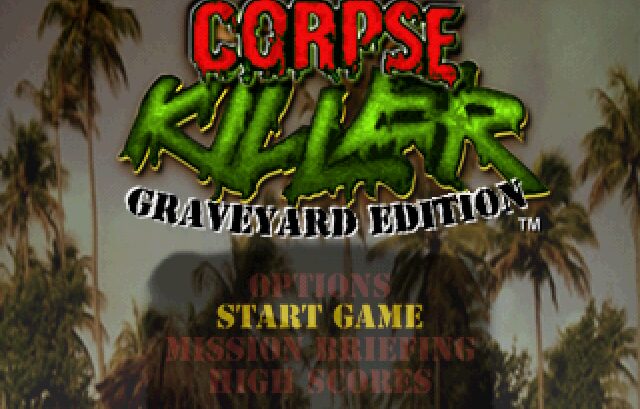
Leave a comment